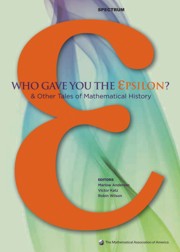Book contents
- Frontmatter
- Introduction
- Contents
- Analysis
- Geometry, Topology and Foundations
- Foreword
- Gauss and the Non-Euclidean Geometry
- History of the Parallel Postulate
- The Rise and Fall of Projective Geometry
- Notes on the History of Geometrical Ideas
- A note on the history of the Cantor set and Cantor function
- Evolution of the Topological Concept of “Connected”
- A Brief, Subjective History of Homology and Homotopy Theory in this Century
- The Origins of Modern Axiomatics: Pasch to Peano
- C. S. Peirce's Philosophy of Infinite Sets
- On the Development of Logics between the two World Wars
- Dedekind's Theorem:√2 × √3 = √6
- Afterword
- Algebra and Number Theory
- Surveys
- Index
- About the Editors
Afterword
from Geometry, Topology and Foundations
- Frontmatter
- Introduction
- Contents
- Analysis
- Geometry, Topology and Foundations
- Foreword
- Gauss and the Non-Euclidean Geometry
- History of the Parallel Postulate
- The Rise and Fall of Projective Geometry
- Notes on the History of Geometrical Ideas
- A note on the history of the Cantor set and Cantor function
- Evolution of the Topological Concept of “Connected”
- A Brief, Subjective History of Homology and Homotopy Theory in this Century
- The Origins of Modern Axiomatics: Pasch to Peano
- C. S. Peirce's Philosophy of Infinite Sets
- On the Development of Logics between the two World Wars
- Dedekind's Theorem:√2 × √3 = √6
- Afterword
- Algebra and Number Theory
- Surveys
- Index
- About the Editors
Summary
Halsted's review is of Volume VII of Gauss's Werke, but in Volume VIII, the editors published Gauss's manuscript material on non-Euclidean geometry. These show that Gauss anticipated much of the work of Bolyai and Lobachevsky, as well as of Schweikart. The existence of these materials does not, however, challenge Halsted's conclusion that Gauss had no influence on the work of any of these men. Roberto Bonola's Non-Euclidean Geometry [2] is still a good source for details on Gauss's work; the English edition also contains Halsted's translations of the fundamental articles on non-Euclidean geometry by Bolyai and Lobachevsky.
More recent works on the history of non-Euclidean geometry include Jeremy Gray's Ideas of Space: Euclidean, non-Euclidean and Relativistic [10] and János Bolyai, Non-euclidean Geometry and the Nature of Space [11] and B. A. Rosenfeld's A History of Non-Euclidean Geometry [17]. The latter work, in particular, deals in great detail with the work of “certain Arabs and Persians” that Lewis skips over. In fact, it is now clear that some of the Islamic work on the parallel postulate was read in Europe in the seventeenth century and affected the European developments on the subject. Jeremy Gray has also written a historically-based textbook in geometry, Worlds out of Nothing: A Course in the History of Geometry in the 19th Century [12], that covers in detail not only non-Euclidean geometry but also projective geometry and many other topics. Julian Lowell Coolidge himself expanded on his article on projective geometry in A History of Geometrical Methods [4], first published in 1940.
- Type
- Chapter
- Information
- Who Gave You the Epsilon?And Other Tales of Mathematical History, pp. 192 - 194Publisher: Mathematical Association of AmericaPrint publication year: 2009



